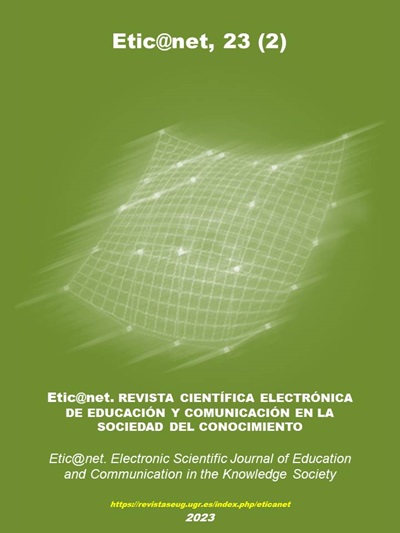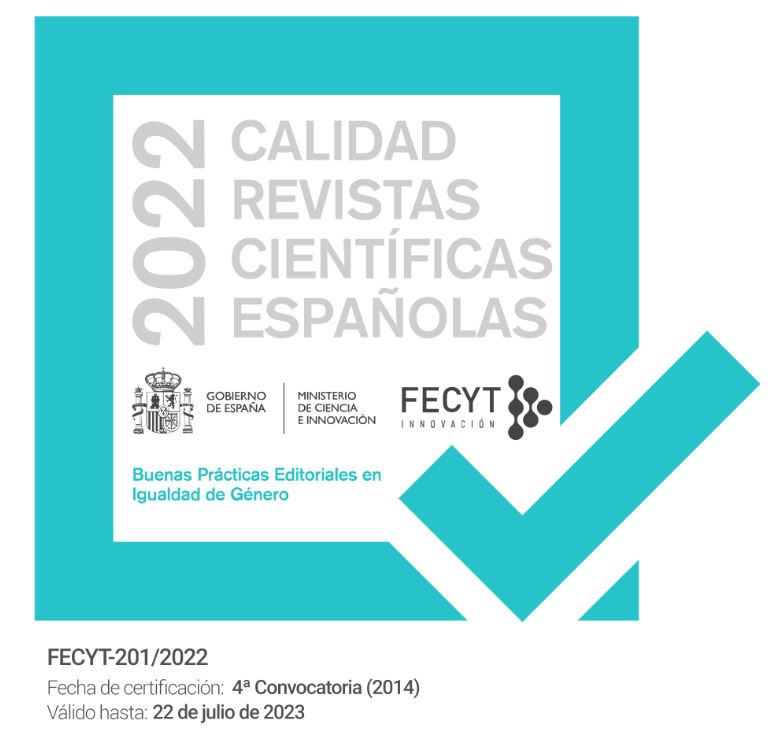Teaching of ethics in bachelor's degrees in Journalism: the stand-alone course and the saturation method in the spanish curricula
DOI:
https://doi.org/10.30827/eticanet.v23i2.27323Keywords:
Ethics, Journalism education, University teaching, CurriculaAbstract
This article analyzes the state of ethics instruction in bachelor's degrees in Journalism at spanish universities. This training is torn between its focus in a stand-alone course or its dispersion in the different subjects that make up the curriculum (“saturation method”). It is useful to know if the general tendency to reduce the humanistic content of journalism studies has affected the teaching of media ethics. For this purpose, the offer of stand-alone courses on journalistic ethics in 38 universities were analyzed through a content analysis. In a complementary way, the existence of other courses on moral philosophy was registered and the presence of contents related to ethics in the set of courses was identified through the analysis of 1749 syllabus. The results allow us to conclude that the inclusion of a specific subject on professional ethics continues to be the hegemonic method, although its content (especially in the deontological aspect rather than that relating to moral philosophy) appears transversally represented in the curricula as a whole
Downloads
References
Agejas, J. A., Parada, J. L., y Oliver, I. (2007). La enseñanza de la ética profesional en los estudios universitarios. Revista Complutense de Educación, 18(2), 67-84. Disponible en https://revistas.ucm.es/index.php/RCED/article/view/RCED0707220067A [Consulta 2023, Enero 31].
Aznar, H. (2005). Ética de la comunicación y nuevos retos sociales: Códigos y recomendaciones para los medios. Barcelona: Paidós.
ANECA (2005). Libro blanco. Títulos de grado en comunicación. Agencia Nacional de Evaluación de la Calidad y la Acreditación. Disponible en http://www.aneca.es/var/media/150336/libroblanco_comunicacion_def.pdf [Consulta 2023, Enero 31].
Christians, C. G. y Covert, C. L. (1980). Teaching Ethics in Journalism Education. Nueva York: The Hastings Center.
Codina, M. (2013). Teaching communication ethics: improving the philosophical mind”. Doxa Comunicación, 16, 211-220. DOI: https://doi.org/10.31921/doxacom.n16a9
Díaz del Campo, J. (2014). La ética y el derecho de la información: ¿las dos caras de una misma moneda? Palabra Clave, 17(1), 130-149. DOI: https://doi.org/10.5294/pacla.2014.17.1.5
Díaz del Campo, J. (2013). El lugar de la ética en la formación del periodista. Un estudio de la situación en la Unión Europea. Cuadernos.info, 33, 113-120. DOI: https://doi.org/10.7764/cdi.33.529
EJTA (2020). Tartu Declaration 2020. European Journalism Training Association. Disponible en https://www.ejta.eu/tartu-declaration-2020 [Consulta 2023, Enero 31].
Gómez Monpart, J. L. (2016). Docencia y didáctica de los grados. En J.L. Gómez Monpart, y M. Herrero Subías, M. (coords.) Jornadas de formación y empleo en comunicación. (pp. 11-75). Madrid: Asociación Española de Universidades con Titulaciones de Información y Comunicación.
Jiménez, E. (2016). La enseñanza universitaria de la ética y deontología periodísticas y los desafíos morales de los informadores en España. Encuentros y desencuentros entre la Academia y la profesión en la transición al Espacio Europeo de Educación Superior. Barcelona: Universitat Ramon Llull. Tesis doctoral. Disponible en http://hdl.handle.net/10803/352227 [Consulta 2023, Enero 31].
Linde-Navas, A. (2009). Teorías y procedimientos de educación moral en ética y deontología de la comunicación. Comunicación y sociedad, 22(2), 35-58. Disponible en https://hdl.handle.net/10171/8636 [Consulta 2023, Enero 31].
Martín-Jiménez, V., Sánchez-García, P. y Etura Hernández, D. (2021). La formación universitaria en Historia del Periodismo español: un estudio longitudinal desde las licenciaturas a los grados (2000-2020). Doxa Comunicación, 32, 23-40. DOI: https://doi.org/10.31921/doxacom.n32a1
Plaisance, P. L. (2007). An assessment of media ethics education: Course content and the values and ethical ideologies of media ethics students. Journalism and Mass Communication Educator, 61(4), 378–396. DOI: https://doi.org/10.1177/107769580606100404
Real Rodríguez, E. (2009). Los estudios de Periodismo y el EEES: ¿Avance o retroceso?. Icono 14, 7(3), 8-34. DOI: https://doi.org/10.7195/ri14.v7i3.300
Sánchez-García, P. (2017). Periodistas (in)formados. Un siglo de enseñanza periodística en España: historia y tendencias. Madrid: Editorial Universitas.
Sánchez-García, P. (2016). The effects of the first phase of the EHEA in journalism education in Spain: more specialized and practical training. Communication & Society 29(1), 125-143. DOI: https://doi.org/10.15581/003.29.1.125-142
Swenson-Lepper, T., Leavitt, M. A., Hoffer, M., Charron, L. N., Ballard, R. L., Bell McManus, L. M., Holba, A. M., Jovanovic, S. y Tompkins, P. S. (2015) “Communication Ethics in the Communication Curriculum: United States, Canada, and Puerto Rico”, Communication Education, 64(4), 472-490. DOI: http://dx.doi.org/10.1080/03634523.2015.1041996
Tejedor, S. y Cervi, L. (2017). Análisis de los estudios de Periodismo y Comunicación en las principales universidades del mundo. Competencias, objetivos y asignaturas. Revista Latina de Comunicación Social, 72, 1626-1647. DOI: https://doi.org/10.4185/RLCS-2017-1238
Vázquez, F. (dir.) (2002). Análisis de la enseñanza de la ética y la deontología profesional en las facultades de Ciencias de la Información de España. Madrid: Helsinki España Dimensión Humana / Universidad Complutense de Madrid.
UNESCO (2007). Plan modelo de estudios de periodismo. Organización de las Naciones Unidas para la Educación, la Ciencia y la Cultura. Disponible en: https://unesdoc.unesco.org/ark:/48223/pf0000151209_spa [Consulta 2023, Enero 31].
Downloads
Published
Issue
Section
License
The authors who publish in this journal agree to the following terms: The authors retain the copyright and grant the journal the right to be the first publication of the work as well as licensed under a Creative Commons Attribution License that allows others to share the work with an acknowledgment of the authorship of the work and the initial publication in this magazine. Authors are allowed and encouraged to disseminate their work electronically (for example, in institutional repositories or on their own website) before and during the submission process, as it may lead to productive exchanges as well as further citation. Earliest and greatest of published works (See The Effect of Open Access).













